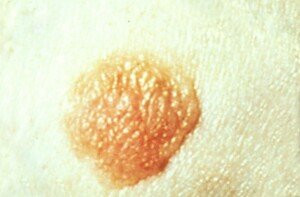
If you’ve ever had a mole removed for biopsy, have you ever wondered what the mathematical odds were of it coming back as melanoma?
It’s unimaginable how many moles every year in the U.S. or any other given industrialized nation are removed for biopsy on a yearly basis.
The number must be astronomical, but the percentage of these mole biopsies that come back positive for melanoma would be a constant, not a variable, as long as the parameters remained the same (e.g., only those moles that a dermatologists finds suspicious).
For instance, five percent of 100,000 is the same “odds” as five percent of 100 million.
Percentage of Mole Biopsies that Are Positive for Melanoma
“The percentage of mole biopsies that come back as melanoma is dependent on why the mole is biopsied,” begins Jena Martin, MD, a board certified anatomic and dermatopathologist based in the Minneapolis area.

Common mole
“I like to think of this concept (statistically called the positive predictive value) as ‘garbage in, garbage out.’
“So if your doctor biopsies a mole that he or she believes is benign, the odds it will be melanoma is nearly zero.
“When we look at biopsies of moles that dermatologists are worried about (moles that look odd or funny), the typical rate is about 15-20 biopsied needed to diagnose melanoma.
“In the medical literature this is called the number needed to diagnose (NND).
“For every 15-20 worrisome moles that a dermatologist biopsies, they can expect to find one melanoma.”
What does this mean in terms of percentage?
Let’s look at the upper end of this: one in 20. A ratio of one out of every 20 is five percent.
If you recall your grade school math, to figure out a percent, divide the “out of every” number INTO the smaller number.
So one divided by 20 equals 0.05. Move the decimal to the right two places to get 5: five percent.
Using this grade school formula to figure out percentages, you’ll see that one out of 15 means 6.6 percent.
So if a dermatologist wants a suspicious spot removed, the odds that this will come back as the deadliest skin cancer are 5 to 6.6 percent.
But remember, this percentage pertains strictly to moles that a dermatologist is concerned about.
If the doctor says, upon examining your moles, “I’d like to remove this one here because its network gets my attention,” then there is probably a 5 to 6.6 percent chance that you’ll get horrible news.
“Many moles that are benign are also removed for cosmetic reasons, or because a patient is worried and the dermatologist is not; those don’t count in that statistic,” says Dr. Martin.
A study of over 80,000 skin samples which included lesions other than moles, that were sent out for biopsy, turned up a different percentage rate of melanoma diagnoses. Continue reading…










































